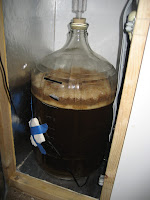 Just like I did with the Belgian Pale Ale and Belgian Dubbel, I wanted to try other Belgian yeast strains on the same base wort (Belgian Dark Strong this round). And the easiest (and cheapest) way for me to accomplish this, is by using bottle dregs. When picking what yeasts to use I chose my favorite examples of Belgian Beers that work with dark malts. To be honest, I haven't really met a Dark Belgian beer I disliked.
Just like I did with the Belgian Pale Ale and Belgian Dubbel, I wanted to try other Belgian yeast strains on the same base wort (Belgian Dark Strong this round). And the easiest (and cheapest) way for me to accomplish this, is by using bottle dregs. When picking what yeasts to use I chose my favorite examples of Belgian Beers that work with dark malts. To be honest, I haven't really met a Dark Belgian beer I disliked. For this round, I decide to use the yeast from Maredsous Bruin. From my internet research, I have found that this appears to be the Duvel yeast since Moorgat owns both breweries. The Duvel yeast is supposedly WLP570 and Wyeast 1388. According to White Labs, WLP570 Belgian Golden Ale - "From East Flanders, versatile yeast that can produce light Belgian ales to high gravity Belgian beers (12% ABV). A combination of fruitiness and phenolic characteristics dominate the flavor profile. Some sulfur is produced during fermentation, which will dissipate following the end of fermentation." And I have said before that I really enjoy my Belgian beers with a balance of fruit and phenols. And it looks like this yeast will do well with the high alcohol and provide good attenuation.
 A simple 6-8 oz starter of 1.030 wort was used in the original bottle. This was allowed to build up over several days and then all of it was dumped into the 1 gal batch. There was active fermentation in less than a day and it was going strong. Active fermentation lasted about a week and then the batch was aged for another 1.5 month before being bottled. Fermentation ended at 1.008, which is 90% attenuation and 10.7% ABV.
A simple 6-8 oz starter of 1.030 wort was used in the original bottle. This was allowed to build up over several days and then all of it was dumped into the 1 gal batch. There was active fermentation in less than a day and it was going strong. Active fermentation lasted about a week and then the batch was aged for another 1.5 month before being bottled. Fermentation ended at 1.008, which is 90% attenuation and 10.7% ABV.The initial taste during bottling is nicely balanced with no obvious off-flavors and a decent amount of alcohol heat. The first bottle will be sampled in 6 months.

























